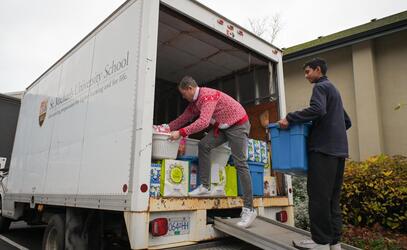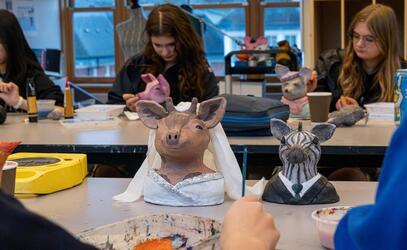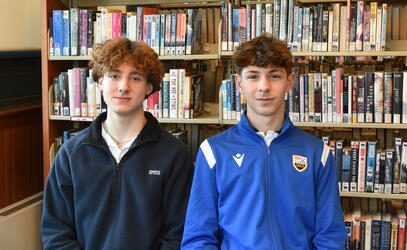1492.
John A. Macdonald.
The Cuban Missile Crisis.
Listen. Memorize. Regurgitate. Repeat. Sadly, that’s what history class was like for so many of us. An endless parade of names, dates, and events. If you weren’t a history buff blessed with a great memory, or fortunate enough to have a gifted storyteller for a teacher, you were probably pretty bored!
And then there was the curriculum. All too often it was a rather lopsided, unquestioning, even jingoistic story designed to promote a sense of pride in our people and their achievements, a story of heroic deeds and inevitable progress. Seldom did we learn about individuals or events who did not fit this tidy narrative. They tended to be whitewashed or omitted entirely. Sure, we learned history – but whose history? And be honest: since then, how often have we actually used what we learned?
Now fast forward to 2021.
Walk into a Senior School social studies class today and you will find a very different scene: students learning about far more than just what happened. You will see them exploring much larger questions:
- Why do events occur? How are they shaped?
- What makes something historically significant?
- How do we even know what happened?
- Whose perspective(s) do we need to consider?
- To what extent can we judge the events of the past?
- Should the traditional narrative be updated?
- What should we do about what happened (both the good and the bad) in the present?
- How can we better prepare ourselves for the challenges of the future?
These deeper questions are what our social studies courses are all about. And it’s why we have put them at the core of Socials Studies 9 and 10, which together explore Canada’s evolution in a global context, from the arrival of the First Peoples through to the present day.
Developing Deeper Historical Thinking
The old social studies content isn’t gone, it has just been given a new purpose. We still teach about significant people, places, and events. But we do so to provide students with the evidence needed for deeper historical thinking. The content becomes the context for thinking conceptually. Students learn facts so they can do things with them. And think. And question. And create new knowledge.
In Social Studies 10, for instance, we still discuss the famous Battle of Vimy Ridge, but stop short of simply accepting the traditional narrative of Vimy as the crucible of Canadian nationhood. Rather, students critically debate its actual significance and ponder the relationship between myth and public memory. The tumultuous events of the 1920s and ’30s offers an ideal case study in the mechanics of historical cause and consequence, and how influential actors, beliefs and conditions can drive change. And when it comes to the Second World War, students familiarize themselves with the larger flow of events so they can ultimately examine Canada’s involvement through a particular ethical lens: proportionality.
This sets up a formal mock trial where students argue for and against the proposition that Canada acted “proportionately” during the war. And culminates in a reflection that evaluates the traditional narrative of the conflict as “the last good war.” Finally, the post-1945 period challenges students to develop their own narrative of Canada’s recent evolution, as they identify key events through their own research, then assess them through the eyes of real Canadians – both famous and little-known – who lived during this period. To what extent, we ask students, is Canada’s recent history a story of conflict, identity, and progress? A tough question, certainly, but also a thought-provoking one. And that’s the whole point.
History Woven with the Present
In our classes, the flow of past events is still presented as a broadly chronological story because we recognize that a good narrative can be engaging and provide students with a framework around which to organize their knowledge. But they are not just learning history. It’s merely the unifying thread that weaves together learning across a range of disciplines: the excuse, if you will, for students to repeatedly explore sociological concepts, anthropological principles, political structures, economic systems, and geographic models.
Nor is our focus always historical. Breaking news is constantly compared, contrasted, and contextualized with references to both past and present events. As we see it, the French Revolution, the Arab Spring, and the ongoing unrest in Myanmar all make more sense – and seem more relevant – when presented as examples of conflict between entrenched interests and popular frustrations. As always, the emphasis is on conceptual understanding over memorized content.
The importance of critical thinking is also emphasized on a daily basis as we peel back the curtain on the practices – and practical challenges – of the social sciences. Whether we are examining the manipulative rhetoric of early Fascists or discussing the impact of Facebook on modern media consumption, students are encouraged to reject simplistic answers, and embrace, instead, complexity and nuance.
We constantly reinforce the point that understanding is not static but rather constructed. What we are learning today merely reflects our best efforts at understanding – given what we know so far – and will surely change as new evidence emerges and analysis shifts. All the more reason, we remind them, to hone their critical thinking skills, for the road ahead is sure to be full of challenging choices. And we need citizens who understand how the world works and will ask the tough questions, with a firm sense of where we have come from.
Clearly, this isn’t your grandparents’ history class... and we believe our students’ understanding of history is all the better for it.


